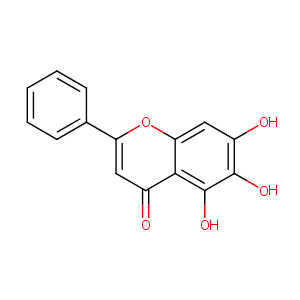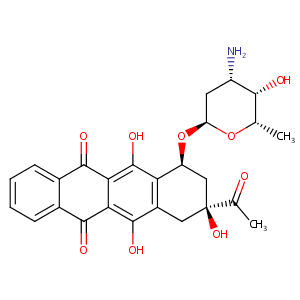| 1 |
Recurrent recessive mutation in deoxyguanosine kinase causes idiopathic noncirrhotic portal hypertension.Hepatology. 2016 Jun;63(6):1977-86. doi: 10.1002/hep.28499. Epub 2016 Mar 31.
|
| 2 |
ClinicalTrials.gov (NCT03830684) A Randomized, Double-blind, Placebo-controlled, Multicenter and Phase IIa Clinical Trial for the Effectiveness and Safety of Baicalein Tablets in the Treatment of Improve Other Aspects of Healthy Adult With Influenza Fever. U.S. National Institutes of Health.
|
| 3 |
Idarubicin FDA Label
|
| 4 |
URL: http://www.guidetopharmacology.org Nucleic Acids Res. 2015 Oct 12. pii: gkv1037. The IUPHAR/BPS Guide to PHARMACOLOGY in 2016: towards curated quantitative interactions between 1300 protein targets and 6000 ligands. (Ligand id: 7083).
|
| 5 |
Mechanisms regulating tumor angiogenesis by 12-lipoxygenase in prostate cancer cells. J Biol Chem. 2006 Jul 7;281(27):18601-9. doi: 10.1074/jbc.M601887200. Epub 2006 Apr 25.
|
| 6 |
Evaluation of inhibitors of intestinal UDP-glucuronosyltransferases 1A8 and 1A10 using raloxifene as a substrate in Caco-2 cells: Studies with four flavonoids of Scutellaria baicalensis. Toxicol In Vitro. 2021 Apr;72:105087. doi: 10.1016/j.tiv.2021.105087. Epub 2021 Jan 10.
|
| 7 |
Stable expression of a human liver UDP-glucuronosyltransferase (UGT2B15) with activity toward steroid and xenobiotic substrates. Drug Metab Dispos. 1994 Sep-Oct;22(5):799-805.
|
| 8 |
Indazolinones, a new series of redox-active 5-lipoxygenase inhibitors with built-in selectivity and oral activity. J Med Chem. 1991 Mar;34(3):1028-36.
|
| 9 |
Rational design of novel, potent small molecule pan-selectin antagonists. J Med Chem. 2007 Mar 22;50(6):1101-15.
|
| 10 |
Discovery of the inhibitors of tumor necrosis factor alpha with structure-based virtual screening. Bioorg Med Chem Lett. 2010 Nov 1;20(21):6195-8.
|
| 11 |
Inhibition of cow's milk xanthine oxidase by flavonoids. J Nat Prod. 1988 Mar-Apr;51(2):345-8.
|
| 12 |
Baicalin, a prodrug able to reach the CNS, is a prolyl oligopeptidase inhibitor. Bioorg Med Chem. 2008 Aug 1;16(15):7516-24.
|
| 13 |
Structure-activity relationship of human GLO I inhibitory natural flavonoids and their growth inhibitory effects. Bioorg Med Chem. 2008 Apr 1;16(7):3969-75.
|
| 14 |
Flavonoids as aryl hydrocarbon receptor agonists/antagonists: effects of structure and cell context. Environ Health Perspect. 2003 Dec;111(16):1877-82.
|
| 15 |
N-acetyltransferase is involved in baicalein-induced N-acetylation of 2-aminofluorene and DNA-2-aminofluorene adduct formation in human leukemia HL-60 cells. In Vivo. 2005 Mar-Apr;19(2):399-405.
|
| 16 |
Effect of the interaction between lipoxygenase pathway and progesterone on the regulation of hydroxysteroid 11-Beta dehydrogenase 2 in cultured human term placental trophoblasts. Biol Reprod. 2008 Mar;78(3):514-20.
|
| 17 |
Blockade of the dioxin pathway by herbal medicine Formula Bupleuri Minor: identification of active entities for suppression of AhR activation. Biol Pharm Bull. 2008 May;31(5):838-46.
|
| 18 |
Structure-function relationships of inhibition of human cytochromes P450 1A1, 1A2, 1B1, 2C9, and 3A4 by 33 flavonoid derivatives. Chem Res Toxicol. 2010 Dec 20;23(12):1921-35.
|
| 19 |
Comparative CYP1A1 and CYP1B1 substrate and inhibitor profile of dietary flavonoids. Bioorg Med Chem. 2011 May 1;19(9):2842-9.
|
| 20 |
Evaluation of the antioxidative properties of lipoxygenase inhibitors. Pharmacol Rep. 2012;64(5):1179-88.
|
| 21 |
Chrysin, baicalein and galangin are indirect activators of the human constitutive androstane receptor (CAR). Toxicol Lett. 2015 Mar 4;233(2):68-77.
|
| 22 |
Drug interaction study of flavonoids toward CYP3A4 and their quantitative structure activity relationship (QSAR) analysis for predicting potential effects. Toxicol Lett. 2018 Sep 15;294:27-36.
|
| 23 |
Baicalein induces cancer cell death and proliferation retardation by the inhibition of CDC2 kinase and survivin associated with opposite role of p38 mitogen-activated protein kinase and AKT. Mol Cancer Ther. 2007 Nov;6(11):3039-48. doi: 10.1158/1535-7163.MCT-07-0281.
|
| 24 |
MiR-3663-3p participates in the anti-hepatocellular carcinoma proliferation activity of baicalein by targeting SH3GL1 and negatively regulating EGFR/ERK/NF-B signaling. Toxicol Appl Pharmacol. 2021 Jun 1;420:115522. doi: 10.1016/j.taap.2021.115522. Epub 2021 Apr 8.
|
| 25 |
Baicalein inhibits the migration and invasive properties of human hepatoma cells. Toxicol Appl Pharmacol. 2011 Sep 15;255(3):316-26. doi: 10.1016/j.taap.2011.07.008. Epub 2011 Jul 23.
|
| 26 |
The role of arachidonic acid and its metabolites in insulin secretion from human islets of langerhans. Diabetes. 2007 Jan;56(1):197-203. doi: 10.2337/db06-0490.
|
| 27 |
The flavonoids induce the transcription of mRNA encoding erythropoietin in cultured embryonic stem cells via the accumulation of hypoxia-inducible factor-1. Chem Biol Interact. 2023 Sep 1;382:110609. doi: 10.1016/j.cbi.2023.110609. Epub 2023 Jun 20.
|
| 28 |
Mechanism analysis of Buyang Huanwu decoction in treating atherosclerosis based on network pharmacology and in?vitro experiments. Chem Biol Drug Des. 2024 Jan;103(1):e14447. doi: 10.1111/cbdd.14447.
|
| 29 |
Effects of luteolin, quercetin and baicalein on immunoglobulin E-mediated mediator release from human cultured mast cells. Clin Exp Allergy. 2000 Apr;30(4):501-8. doi: 10.1046/j.1365-2222.2000.00768.x.
|
| 30 |
Baicalein suppresses HER2-mediated malignant transformation of HER2-overexpressing ovarian cancer cells by downregulating HER2 gene expression. Environ Toxicol. 2023 Jul;38(7):1609-1617. doi: 10.1002/tox.23790. Epub 2023 Mar 29.
|
| 31 |
The ethanol extract of Scutellaria baicalensis and the active compounds induce cell cycle arrest and apoptosis including upregulation of p53 and Bax in human lung cancer cells. Toxicol Appl Pharmacol. 2011 Aug 1;254(3):221-8. doi: 10.1016/j.taap.2011.03.016. Epub 2011 Mar 30.
|
| 32 |
Baicalein induces G1 arrest in oral cancer cells by enhancing the degradation of cyclin D1 and activating AhR to decrease Rb phosphorylation. Toxicol Appl Pharmacol. 2012 Sep 15;263(3):360-7. doi: 10.1016/j.taap.2012.07.010. Epub 2012 Jul 20.
|
| 33 |
Multidisciplinary docking, kinetics and X-ray crystallography studies of baicalein acting as a glycogen phosphorylase inhibitor and determination of its' potential against glioblastoma in cellular models. Chem Biol Interact. 2023 Sep 1;382:110568. doi: 10.1016/j.cbi.2023.110568. Epub 2023 Jun 3.
|
| 34 |
Structure-activity relationship and mechanism of flavonoids on the inhibitory activity of P-glycoprotein (P-gp)-mediated transport of rhodamine123 and daunorubicin in P-gp overexpressed human mouth epidermal carcinoma (KB/MDR) cells. Food Chem Toxicol. 2021 Sep;155:112381. doi: 10.1016/j.fct.2021.112381. Epub 2021 Jul 1.
|
| 35 |
Cellular mechanism for potentiation of Ca2+-mediated Cl- secretion by the flavonoid baicalein in intestinal epithelia. J Biol Chem. 2004 Sep 17;279(38):39310-6. doi: 10.1074/jbc.M406787200. Epub 2004 Jul 3.
|
| 36 |
In vitro effects of some flavones on human pyruvate kinase isoenzyme M2. J Biochem Mol Toxicol. 2015 Mar;29(3):109-13. doi: 10.1002/jbt.21673. Epub 2014 Nov 11.
|
| 37 |
Assessing 12(S)-lipoxygenase inhibitory activity using colorectal cancer cells overexpressing the enzyme. Food Chem Toxicol. 2007 Mar;45(3):508-14. doi: 10.1016/j.fct.2006.08.013. Epub 2006 Aug 30.
|
| 38 |
The autonomous notch signal pathway is activated by baicalin and baicalein but is suppressed by niclosamide in K562 cells. J Cell Biochem. 2009 Mar 1;106(4):682-92. doi: 10.1002/jcb.22065.
|
| 39 |
Quantitative structure activity relationship studies on the flavonoid mediated inhibition of multidrug resistance proteins 1 and 2. Biochem Pharmacol. 2005 Feb 15;69(4):699-708. doi: 10.1016/j.bcp.2004.11.002. Epub 2004 Dec 23.
|
| 40 |
Baicalein represses TGF-1-induced fibroblast differentiation through the inhibition of miR-21. Toxicol Appl Pharmacol. 2018 Nov 1;358:35-42. doi: 10.1016/j.taap.2018.09.007. Epub 2018 Sep 7.
|
| 41 |
Potent Inhibitors of Organic Anion Transporters 1 and 3 From Natural Compounds and Their Protective Effect on Aristolochic Acid Nephropathy. Toxicol Sci. 2020 Jun 1;175(2):279-291. doi: 10.1093/toxsci/kfaa033.
|
| 42 |
Quantitative high-throughput profiling of environmental chemicals and drugs that modulate farnesoid X receptor. Sci Rep. 2014 Sep 26;4:6437. doi: 10.1038/srep06437.
|
| 43 |
Drugs@FDA. U.S. Food and Drug Administration. U.S. Department of Health & Human Services.
|
| 44 |
Human intestinal transporter database: QSAR modeling and virtual profiling of drug uptake, efflux and interactions. Pharm Res. 2013 Apr;30(4):996-1007.
|
| 45 |
Amonafide L-malate is not a substrate for multidrug resistance proteins in secondary acute myeloid leukemia. Leukemia. 2008 Nov;22(11):2110-5.
|
| 46 |
In vitro evaluation of cytochrome P450-mediated drug interactions between cytarabine, idarubicin, itraconazole and caspofungin. Hematology. 2004 Jun;9(3):217-21.
|
| 47 |
A Quantitative Approach to Screen for Nephrotoxic Compounds In Vitro. J Am Soc Nephrol. 2016 Apr;27(4):1015-28. doi: 10.1681/ASN.2015010060. Epub 2015 Aug 10.
|
| 48 |
The use of biochemical markers in cardiotoxicity monitoring in patients treated for leukemia. Neoplasma. 2005;52(5):430-4.
|
| 49 |
The induction of apoptosis by daunorubicin and idarubicin in human trisomic and diabetic fibroblasts. Cell Mol Biol Lett. 2008;13(2):182-94. doi: 10.2478/s11658-007-0045-7. Epub 2008 Apr 10.
|
| 50 |
Refining the human iPSC-cardiomyocyte arrhythmic risk assessment model. Toxicol Sci. 2013 Dec;136(2):581-94. doi: 10.1093/toxsci/kft205. Epub 2013 Sep 19.
|
|
|
|
|
|
|


